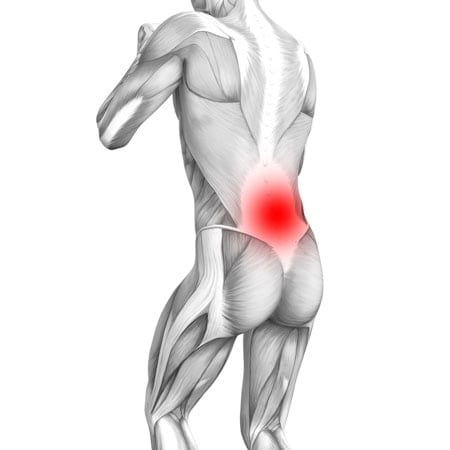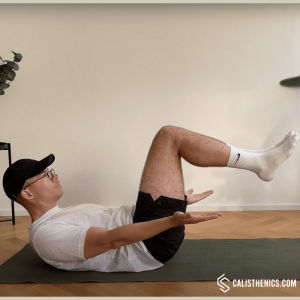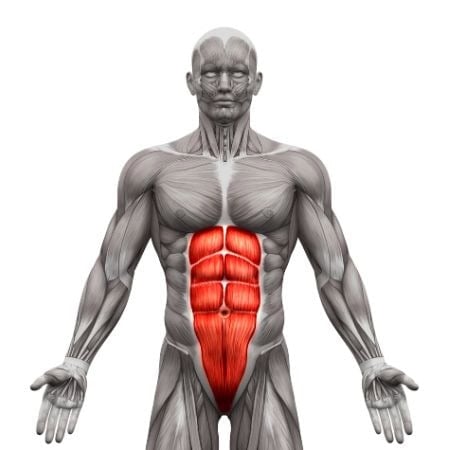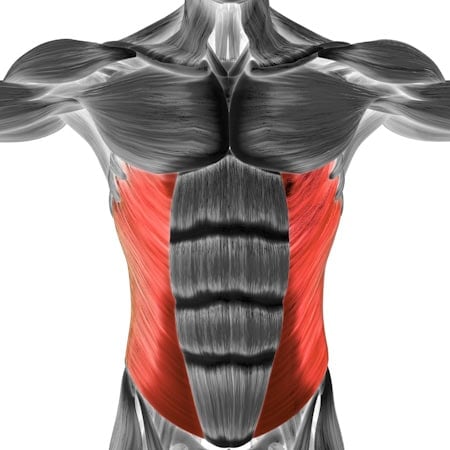Tuck Hollow Body Hold
How to do Tuck Hollow Body Hold?
The tuck hollow body hold is a core exercise that strengthens the abdominals, obliques, and stabilizing muscles throughout the torso. This movement is a modification of the hollow body hold, where the knees are tucked toward the chest, making it slightly easier while still challenging the core. The tuck hollow body hold builds endurance, core stability, and overall body control, making it a popular choice in gymnastics, bodyweight training, and fitness routines focused on core strength.
Steps to Perform a Proper Tuck Hollow Body Hold:
1. Starting Position (Supine):
• Lie flat on your back with your legs extended and your arms resting by your sides. Keep your lower back pressed into the ground to engage your core from the start.
2. Tuck Your Knees Toward Your Chest:
• Bring your knees toward your chest, bending them at about a 90-degree angle. Keep your feet together, and your shins should be parallel to the ground.
• Lift your shoulders slightly off the ground, keeping your head and neck in a neutral position. Your arms should reach forward toward your shins, parallel to the floor.
3. Engage Your Core and Hold:
• Press your lower back into the ground to ensure there is no space between your back and the floor. Engage your core by tightening your abdominals and pulling your belly button toward your spine.
• Hold this position, keeping your core tight and your body still, without letting your lower back arch or your shoulders drop.
4. Maintain the Hold:
• Hold the tuck hollow body position for the desired amount of time, typically starting with 20-30 seconds and increasing as your strength improves. Focus on maintaining a tight core throughout the hold.
Benefits of Tuck Hollow Body Holds
• Strengthens the Core: The tuck hollow body hold effectively targets the entire core, including the rectus abdominis, transverse abdominis, and obliques, building core strength and stability.
• Improves Body Control: Holding the tuck position requires coordination and full-body tension, helping to improve overall body control and awareness.
• Enhances Athletic Performance: This exercise is foundational in gymnastics and bodyweight training because it builds core strength that is essential for performing advanced movements, such as handstands, planches, and levers.
• Supports Lower Back Health: Strengthening the core muscles with this exercise can reduce the risk of lower back pain by improving spine stability and supporting good posture.
• Increases Endurance: Holding the tuck position for extended periods improves muscle endurance, which translates to better performance in other exercises and daily activities.
• Low Impact: The tuck hollow body hold is gentle on the joints, making it a safe and effective option for individuals with joint issues or those recovering from injury.
• Progression to Advanced Core Movements: This exercise is a great stepping stone toward more challenging core exercises like the full hollow body hold, L-sits, and advanced gymnastics holds.
Common Mistakes to Avoid
• Arching the Lower Back: Ensure that your lower back stays pressed firmly into the ground throughout the hold. If your lower back lifts, you’re losing core engagement, which reduces the effectiveness of the exercise.
• Straining the Neck: Avoid lifting your head too high or straining your neck. Keep your head in a neutral position and focus on lifting with your core, not your neck.
• Letting the Legs Drop: Keep your knees tucked and your shins parallel to the floor. If your legs start to drop, readjust your position and re-engage your core.
Tips for the proper execution of Tuck Hollow Body Hold
Core Engagement: Press your lower back into the ground and engage your core throughout the exercise. This is key to maintaining proper form and maximizing the benefits of the hold.
Neck Position: Keep your head and neck in a neutral position. Avoid straining your neck by looking too far forward or back. Keep your gaze toward the ceiling or slightly toward your legs.
Avoid Arching the Back: One of the most important aspects of this exercise is preventing your lower back from arching off the ground. If you notice this happening, focus on re-engaging your core and adjusting your position.
Controlled Breathing: Inhale deeply through your nose and exhale through your mouth while maintaining the hold. Controlled breathing helps keep your core stable and your muscles engaged.
Muscles worked when doing Tuck Hollow Body Hold
Primary Muscles:
•Rectus Abdominis: The main “six-pack” muscle, responsible for flexing the spine and maintaining core stability.
•Transverse Abdominis: Deep core muscles that help stabilize the spine and maintain internal pressure during the hold.
•Obliques: Internal and external obliques help stabilize the torso and prevent rotation during the hold.
Secondary Muscles:
•Hip Flexors: Engaged to help keep the legs in a tucked position.
•Quadriceps: Engaged to stabilize the legs and hold the knees in a bent position.
•Lower Back: Erector spinae muscles are activated to maintain a neutral spine.
•Shoulders: Anterior deltoids and upper back muscles help support the lift of the shoulders off the ground.
Primary Muscle(s):
Secondary Muscle(s):

Lower back
Equipment needed for Tuck Hollow Body Hold
No equipment needed for this exercise.
Adjust the difficulty of Tuck Hollow Body Hold
How to make Tuck Hollow Body Hold harder?
How to make Tuck Hollow Body Hold easier?
How to make Tuck Hollow Body Hold harder?
To make Tuck Hollow Body Hold harder:
-
Extend the Legs: Straighten your legs while maintaining the hollow body position. This increases the demand on your core and hip flexors.
-
Increase the Hold Duration: Hold the position for longer, such as 45-60 seconds, to challenge your endurance and core strength.
-
Add Arm Extensions: Instead of reaching forward, extend your arms overhead in line with your ears while keeping your legs tucked. This adds more difficulty by shifting the weight further away from your core.
-
Weighted Hold: Place a small weight plate or dumbbell in your hands, either keeping your arms extended overhead or reaching toward your knees, to increase the intensity.
How to make Tuck Hollow Body Hold easier?
To make Tuck Hollow Body Hold easier:
-
Keep Your Shoulders Lower: If lifting your shoulders too high off the ground feels too challenging, reduce the lift. Focus on engaging your core and keeping your lower back pressed to the floor.
-
Reduce the Hold Time: Start with shorter holds (10-15 seconds) and gradually increase the duration as your core strength improves.




